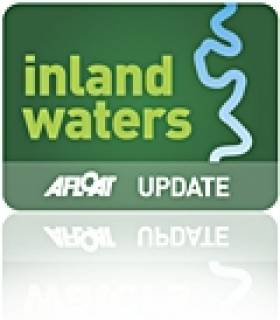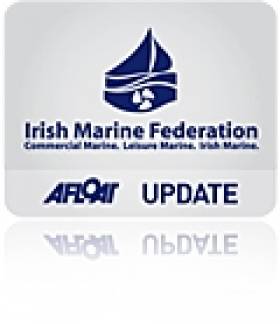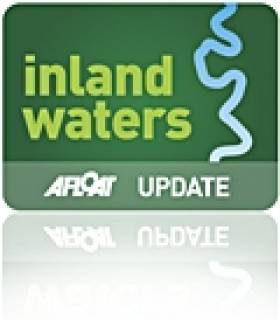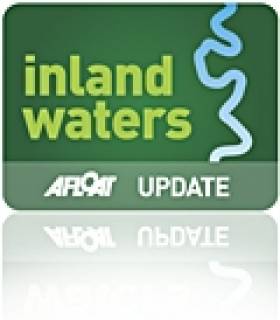Displaying items by tag: Shannon
Second Attempt to Airlift Injured Crewman Successful
The Shannon-based Coast Guard Helicopter reached the boat shortly before 2pm and succeeded in taking the fisherman, an Egyptian national, on board.
The man, who had sustained serious injuries after being struck by a steel hawser, was to be taken to Cork University Hospital.
An earlier attempt to airlift him from the vessel when it was 110km south of Kinsale had to be abandoned when the helicopter flew into a snowstorm and its cockpit window iced over.
'Keenan's of Tarmonbarry' Wins Taste Of Waterways Award
The winner of the prestigious Taste of the Inland Waterways Award was revealed this week by Georgina Campbell as "Keenan's of Tarmonbarry".
Presenting the Taste of the Waterways Award to Keenan's of Tarmonbarry, Martin Dennany, Director of Marketing and Communications, Waterways Ireland stated "Keenan's of Tarmonbarry epitomises the waterway dining experience and I am delighted to present this Taste of the Waterways Award and to commend Georgina Campbell on her choice. With the recent completion of the link between the Royal Canal and the Shannon Navigation, we hope that many will take the opportunity to visit the area and to experience for themselves the delights of waterside hospitality at this fine establishment. Waterways Ireland is happy to sponsor this award and to recognise the contribution that businesses like Keenan's make to the tourism industry".
The Taste of the Waterways Award was first introduced in 2008 and runs in conjunction with "The Taste of Waterways" booklet, a publication produced by Waterways Ireland in partnership with Georgina Campbell highlighting the excellent hospitality of the waterway experience. The guide is free and updated regularly with Georgina's selection of establishments of all kinds serving food and hospitality all along the inland waterways.
Martin Dennany commenting on the guide stated "The judging criteria and standard of assessment for the Taste of the Waterways Georgina Campbell guide is very high, with selection made on merit alone: no payment is charged for entry, no payments accepted for advertising".
Georgina Campbell described Keenan's as "Just beside the bridge over the Shannon in Tarmonbarry, this well-run bar and restaurant has been a favourite watering hole for river folk for many years - and it makes a great place to break a journey between Dublin and the north-west. The range is wide, offering wholesome, hearty fare that pleases all age groups and includes very welcome traditional dishes. But it's for their steaks, above all, that people beat a path to Keenan's of Tarmonbarry - and why wouldn't they? Whether you go for a classic sirloin, a big juicy fillet, or their renowned steak sandwich, the steaks at this hospitable watering hole are not to be missed."
Dublin Boat Show Goes Afloat
The 2011 Dublin Boat Show is going on the water in 2011 if a new approach to promote boating in Ireland takes off. The Irish Marine Federation (IMF) aims to include as many boating activities as possible in the national boat show line up next May in Malahide.
An attendance of up to 17,000 are expected at the Malahide marina venue from May 20 to 22. It will be the first time the national event has taken to the water in its 50 year history.
The world's biggest boat builders Beneteau, Jeanneau, Sea Ray and Sunseeker among others have already signed up for the North Dublin event, according to the IMF.
The organisers are partnering with leading Irish boating organisations to demonstrate the many different aspects of the sport on the water with a weekend schedule of live commentary.
BJ Marine, MGM Boats, Western Marine, HM Yachts in Cork and Viking marine of Dun Laoghaire and Shannon Castle Line in County Clare are among the first of the Irish firms to express interest in the new format as exhibition details circulate through the industry this week.
The aim is to get as many class associations on the water as well as small powerboat racing such as Zzapcats, kayaking and match racing fans to stage short, sharp events on the estuary directly in front of the marina. A timetable of events will be published shortly.
Coastguard and Lifeboat demonstrations are also planned. Technical demonstrations such as glass fibre repairs and engine maintenance are also in the line up.
Despite the coastal setting Ireland's Inland waters will feature prominently too through the Irish Boat Rental Association who will be promoting holidays on the river Shannon and Erne.
Visitors are also expected from Wales and across the Irish Sea region and special offers to both show-goers and exhibitors are being made through an Irish Sea InterReg programme.
The Malahide exhibition site will feature a marine village ashore with over 500 square meters of undercover exhibit space. Show goers will get the chance to talk to the leading lights in the sport before going afloat on the marina where over 100 berths will be available.
"It's a pretty unique site that gives us the best chance to show off the marine leisure industry afloat and ashore. Because its just off the M50 and M1 motorways it means it's also so easy to get to from anywhere in the country. This will be a great day out." said the Federation's Steve Conlon.
More information from Steve Conlon on 087 6472746. Updates here on afloat.ie as the show takes shape.
New Houseboat Facility Gets Green Light on the Shannon
Following receipt of planning permission, Inland Waterways Ireland is progressing with the development of a houseboat facility in Shannon Harbour where the Grand Canal meets the Shannon.
The result will be a serviced mooring facility in Shannon Harbour for 6-8 boats. This will include moorings, area lighting, electricity and water.
A section of the Grand Canal, from the 34th Lock to the 35th Lock inclusive, will be closed to navigation between 1st November 2010 and 14th March 2011 to facilitate the improvement works. The towpaths will also be closed during the period of the works.
The design and commissioning of the work has been undertaken by Waterways Ireland. The tenders are currently being assessed and will be awarded shortly.
Lough Ree Yacht Club Annual Regatta Underway
Inland Waterways Vessels on Lough Ree at Athlone may meet large fleets of sailing craft at the southern end of Lough Ree approximately 3km north of Athlone due to Lough Ree Yacht Club Annual Regatta currently taking place.
Masters are requested to give racing fleets a wide berth where possible, however, if it is necessary to pass through a fleet to do so with due caution. The regatta will finish this Friday, 6th Aug 2010.
Marine VHF Channel 16 will be monitored by the principal race officer throughout the regatta.
Welcome to Afloat TV

Since 2003 the team behind Afloat magazine has also been producing high-end, internationally appealing and entertaining factual documentaries on the Irish waterways. The production team are a mix of creative, technical and business people whose expertise guarantees an innovative approach to production and a high-quality finished product. The focus is on marine based programmes which entertain and educate. The work has been broadcast on RTE One and internationally on Sky Channels.
The Bay
Screened on RTE One in 2005.
Take a trip around the one half of Ireland's capital city you probably know the least. A new four-part documentary series, The Bay will be screened over four consecutive Wednesdays in May. Using spectacular aerial and underwater footage, the series features a combination of personality-led interviews and themes to tell the story of Dublin's unique waterway. Dublin Bay stretches over six kilometres, from Howth Head on its northern tip to Dalkey Island in the south. It's a place most Dubliners simply take for granted, and one of the capital's least visited places. But there's more going on out there than you'd imagine. And that's why The Bay was made. The series introduces viewers to the rich diversity of activities and personalities around the bay, while also touching on the serious environmental and political issues facing it. Find out more about the bay here.
The Harbour
Screened on RTE One in 2007.
It’s one of the largest natural harbours in the world – and those living near Cork Harbour insist that it’s also one of the most interesting. This was the last port of call for the most famous liner in history, the Titanic, but it has been transformed into a centre for chemical and pharmaceutical industry. Giraffe wander along its shores, from which tens of thousands of men and women left Ireland, most of them never to return. The harbour is home to the oldest yacht club in the world, and to the Irish Navy. This deep waterway has also become a vital cog in the Irish economy. ‘The Harbour’ is not a history programme, nor is it a news focus. It’s simply an exploration of this famous waterway, its colour and its characters. Find out more about the harbour here.
The Estuary
Screened on RTE One in 2007.
The story of the Shannon estuary might well be one of neglect, except that against the odds this waterway has become one of Ireland's greatest natural resources. Windswept, sitting on the edge of the Atlantic, often ignored by the nation. The story of the Shannon estuary might well be one of neglect, except that against the odds this waterway has become one of Ireland's greatest natural resources. A new four-part documentary series, from the makers of RTÉ's The Bay and The Harbour series, uncovers the secrets of the Shannon Estuary. From flying boats to film-making, wildlife to wind-farms, the series reveals how a 100km-stretch of the Shannon waterway has become a hotbed for innovation in Ireland. Up to 40% of Irish energy needs are met here, on the shores of a waterway that is also home to Ireland's second largest airport, a 10,000 student university and a massive cargo port. Ireland - and the world - has learned from the estuary. The first duty free shop was opened here, along with the first industrial free zone. Over the years, thousands of business and political leaders from across the globe have come to Shannon to discover its secret - in the hope that they might copy it. Long before Ireland heard of green energy, this place was producing it. Listen in to dolphin conversations beneath the Shannon's waterline. Uncover the mystery of the Ark, the church on wheels built by a priest who prayed when the tide went out. Narrated by Brenda Fricker, the series aired on Friday nights at 7.30pm on RTÉ One from May 4th 2007. Find out more about the estuary here.
The Navy
Screened on RTE One in 2007.
60 years of the Irish Naval Service. Celebrating the 60th anniversary of the Irish Naval Service, this 3 x half-long feature documentary shows how the Service has evolved into a multi-tasking, multi-disciplinary force. Most Irish people rarely come into contact with the Naval Service, and so are unaware of the range of activities it undertakes. This documentary provides an ideal opportunity to reveal the full extent of the Service’s duties – and the commitment of those who serve on Ireland’s fleet.
The Regattas
Screened on RTE One, 2007 and Sky Sports in 2009.
Sailing featured in RTE’s Christmas schedules this year, with the broadcast of a half-hour documentary feature on the Volvo Dun Laoghaire Regatta 2007. The production, entitled ‘The Regatta’, was shot over four days in Dublin Bay during this year’s regatta. Made by Baily Films, the company behind earlier critically-acclaimed water-based documentaries The Bay, The Harbour, The Estuary and The Navy, it features spectacular on-board footage from a range of craft competing in the event. The Regatta takes viewers both on board the competing craft, and behind the scenes, to examine the challenges thrown up by organising such a large-scale event on the bay. The Regatta was broadcast on RTE 1 on Saturday, December 22, at 4.20pm.
IN DEVELOPMENT
Afloat TV projects at an advanced stage of development include:
The Edge of Ireland
Ireland’s attitude to the seas that surround her is one of the most curious in the world. An island nation, with more coastline than most other European nations, most of her citizens look inland.
Yet no-one in Ireland lives further than 100 kilometres from the sea, and the majority of the population are housed within 10 kilometres of the coast.
More than any other European nation, our history is written on our shores. The very first settlers clung to it, fearing to explore inland. The shores fed and sustained them, and continued to sustain communities from Malin Head to Mizen Head for the next 9,000 years.
From the fort of Dun Aengus to the fields at Carnsore Point, from Inishvickillane to Bull Island, the coastline holds a key to our understanding of Ireland and ourselves.
The Edge of Ireland will uncover that hidden history of Ireland, and explore what the future holds for our coastline. Travelling around the coast, it will use local and national experts to relate individual accounts of how the sea has connected with the land to shape a local community or the nation at large.
The six half-hour series will be presented thematically, rather than using a linear journey up and down the coastline.
CONTACT
If you're keen on promoting Ireland's waterways and would like to get involved with Afloat TV please email us here.
































































